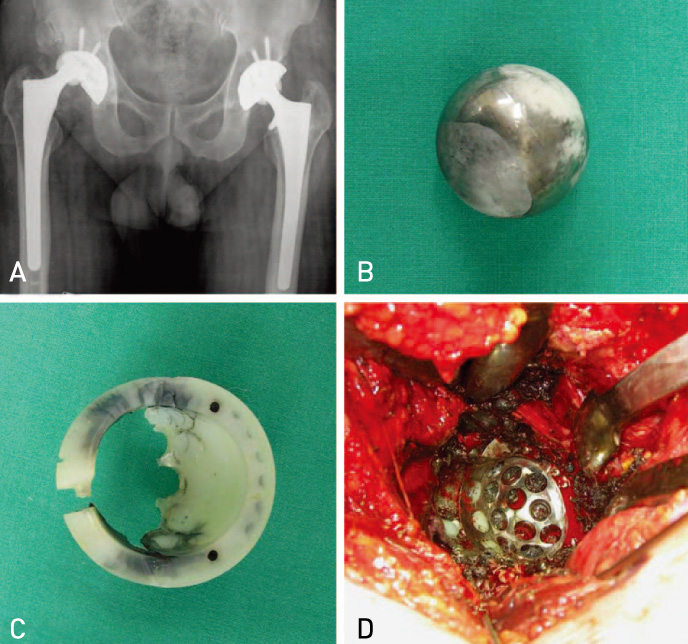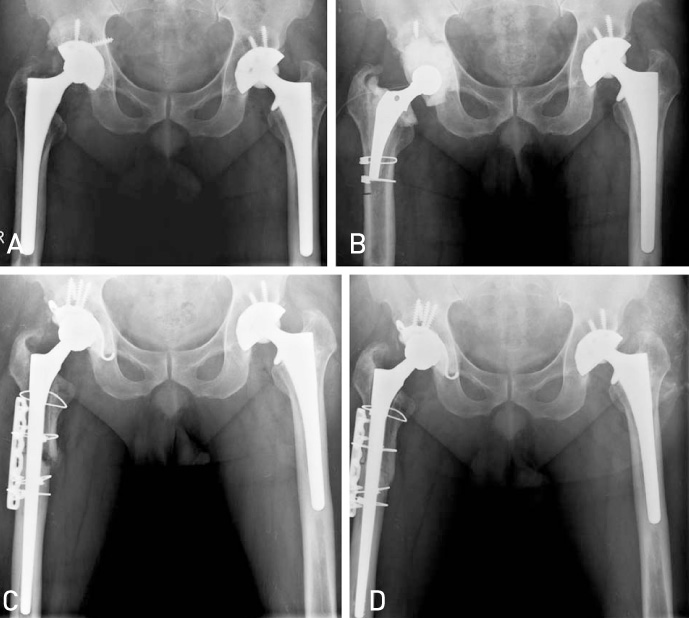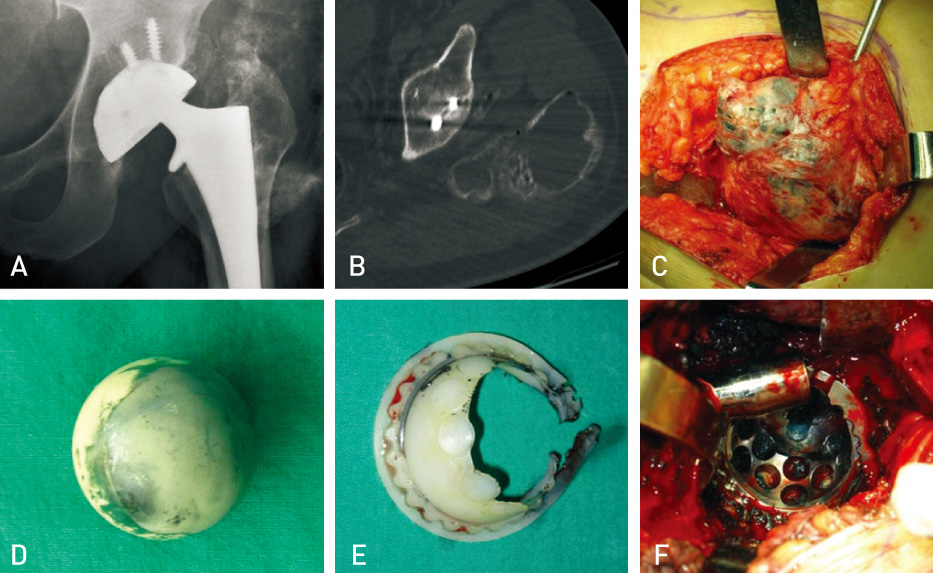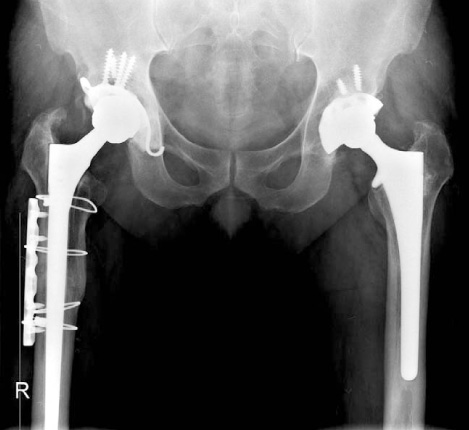Hip Pelvis.
2012 Jun;24(2):148-152. 10.5371/hp.2012.24.2.148.
Bilateral Catastrophic Acetabular Component Failure after Ceramic-on-Polyethylene Total Hip Arthroplasty: A Case Report
- Affiliations
-
- 1Department of Orthopaedic Surgery, Chonnam National University Hwasun Hospital, Chonnam National University Medical School, Jeonnam, Korea. ospks@jnu.ac.kr
- KMID: 1439104
- DOI: http://doi.org/10.5371/hp.2012.24.2.148
Abstract
- Ceramic-on-polyethylene components have better wear characteristics than metal-on-polyethylene components in total hip arthroplasty (THA), and thus, extensive wear resulting in penetration of the femoral head through the acetabular cup is rare after ceramic-on-polyethylene THA. However, several reports have been issued regarding catastrophic polyethylene failure in ceramic-on-polyethylene systems. Here, the authors report the first case of bilateral complete polyethylene wear failure with acetabular cup perforation after ceramic-on-polyethylene THA.
Keyword
Figure
Reference
-
1. Clarke IC, Gustafson A. Clinical and hip simulator comparisons of ceramic-on-polyethylene and metal-on-polyethylene wear. Clin Orthop Relat Res. 2000. (379):34–40.
Article2. Min BW, Song KS, Kang CH, Won YY, Koo KH. Polyethylene liner failure in second-generation Harris-Galante acetabular components. J Arthroplasty. 2005. 20:717–722.
Article3. Needham J, Burns T, Gerlinger T. Catastrophic failure of ceramic-polyethylene bearing total hip arthroplasty. J Arthroplasty. 2008. 23:627–630.
Article4. Mariconda M, Silvestro A, Mansueto G, Marinò D. Complete polyethylene wear-through and secondary breakage of the expansion cup in a ceramic-polyethylene total arthroplasty. Arch Orthop Trauma Surg. 2010. 130:61–64.
Article5. Khan RJ, Wimhurst J, Foroughi S, Toms A. The natural history of metallosis from catastrophic failure of a polyethylene liner in a total hip. J Arthroplasty. 2009. 24:1144.e1–1144.e4.
Article6. Kim YH. Comparison of polyethylene wear associated with cobalt-chromium and zirconia heads after total hip replacement. A prospective randomized study. J Bone Joint Surg Am. 2005. 87:1769–1776.
Article7. Kim SY, Kim DH, Oh CW, Kim PT, Ihn JC, Kim SY. Total hip arthroplasty with the use of nonmodular cementless acetabular component. J Arthroplasty. 2005. 20:632–638.
Article8. von Schewelov T, Sanzèn L, Onsten I, Carlsson A. Catastrophic failure of an uncemented acetabular component due to high wear and osteolysis: an analysis of 154 omnifit prostheses with mean 6-year follow-up. Acta Orthop Scand. 2004. 75:283–294.
Article9. Orishimo KF, Sychterz CJ, Hopper RH Jr, Engh CA. Can component and patient factors account for the variance in wear rates among bilateral total hip arthroplasty patients? J Arthroplasty. 2003. 18:154–160.
Article10. Wan Z, Boutary M, Dorr LD. The influence of acetabular component position on wear in total hip arthroplasty. J Arthroplasty. 2008. 23:51–56.
Article
- Full Text Links
- Actions
-
Cited
- CITED
-
- Close
- Share
- Similar articles
-
- Ceramic Head Fracture in Ceramic-on-Polyethylene Total Hip Arthroplasty
- A Case of Failure of a Ceramic Head in Total Hip Arthroplasty: A Case Report
- Retrieval Study of Total Hip Arthroplasty with Use of a Cemented Polyethylene Cup and a Non-cemented Polyethylene Liner in Combination with Zirconia Ceramic Femoral Head: Report of 2 Cases
- Failure of a Metal Femoral Head after Revision Total Hip Arthroplasty for a Ceramic Liner Fracture
- Pseudotumor and Subsequent Implant Loosening as a Complication of Revision Total Hip Arthroplasty with Ceramic-on-Metal Bearing: A Case Report





